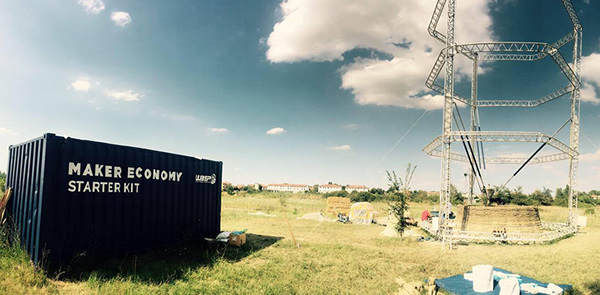Architectural project showcases the maker movement
With the Maker Economy Starter Kit, WASP suggests a living concept and an economical point of view. The project showcases how 3D printing can create a huge, moving technological village. The project will be set up in a 400m2 area at the Rome Maker Faire from 14th to 16th October 2016.
The Maker Economy Starter Kit highlights the self-production economy that can be set up anywhere. WASP’s CEO Massimo Moretti explained: “Our aim is to create micro-independent communities, born on and developed by community knowledge thanks to advanced self-production systems which are accessible for everyone. 3D printing is the production process which has created the no-debt-house: a house which offers people more freedom, a dynamic and self-sufficient house which produces energy instead of using it. A zero-cost living solution able to satisfy all primary human needs: housing, food, energy, health, job and culture. It can also be helpful in case of humanitarian emergencies caused by economic or political crisis or in the case of natural disasters. By allowing them to easily operate in difficult situations or areas, it is also a useful instrument for humanitarian organisations, civil protection, NGOs, national and international institutions.”

The Starter Kit was designed to build houses using both natural and recycled materials taken from the point of origin, as well as standard building materials. Thanks to this technology, the accumulated knowledge can be shared everywhere via the web. All necessary information to set up a Starter Kit can be freely supplied online through a series of tutorials which encourage users to make their ideas a reality. The house project, together with its contents, is open source and lets project-managers, designers, engineers and architects log-in and freely take and exchange contents. In the Kit, all Delta WASP models are included: from Big Delta, the 12m high 3D-printer able to build houses, to theDelta WASP 3MT, the multi-tools printer which produces furniture components, vertical gardens and middle-size items together with other building digital systems produced by WASP to make smaller articles. Other systems are included including: cut systems, material extrusion systems, supply-systems, recycling ruins or plastic material systems.
During the exhibition it will be possible to assist with the running of the machinesaslaboratories and workshops will show applications of WASP’s technology. A stage will be set in the middle of the 12m printing system upon which the Viaggio a Shamballa (Journey to Shamballa), will be read. On stage anyone can put forward and tell their own interpretation of the project.
Thanks to FabLab Venice, the exhibition area will be transformed into a non-stop working laboratory in which in-scale products and printing will take place using multiple materials to create a residential unit with vertical gardens. FabLab Venezia will also introduce its tailor-made system for the 3D-printable house project.





